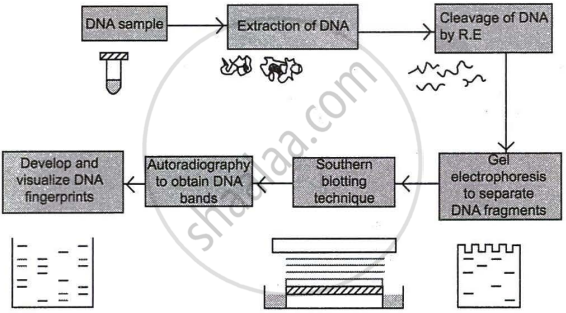Advertisements
Advertisements
प्रश्न
Name and describe the steps involved in the technique widely used in forensics that serves as the basis of paternity testing in case of disputes.
उत्तर
DNA fingerprinting is a technology used to do a paternity test to determine the true parents of a newborn infant. This approach is also known as "DNA profiling" since the DNA sequences of both parents and child are matched. To perform the paternity test, the following steps are involved:
- DNA sample: A DNA sample to be analysed is first collected.
- Extraction of DNA: DNA is then extracted from the sample by lysis method.
- Digestion by restriction endonucleases: Using a specific restriction enzyme, a DNA fragment is cut at a specific site. This is done to obtain RFLP (Restricted Fragment Length Polymorphism).
- Electrophoresis: Using gel electrophoresis, DNA fragments of various sizes are obtained.
- Denaturing DNA fragments: The gel containing DNA fragments is then immersed in NaOH solution. This will denature DNA into single-stranded DNA.
- Southern blotting technique: This is performed to transfer single-stranded DNA from the gel onto the nitrocellulose membrane.
- Hybridization: This DNA fragment is subjected to hybridization with a suitable DNA probe tagged with a radioactive substance.
- Comparing the sample: Using X-ray films, the DNA samples showing radioactivity are compared. This is the most reliable technique to find the parents of the newborn baby.

संबंधित प्रश्न
Write down the full form of R.F.L.P.
Briefly describe the following:
Polymorphism
In gene cloning the DNA of interest is integrated in a ______.
Which of the following process is carried out by restriction endonuclease used in DNA fingerprinting?
VNTR has ______.
Which of the following is the technique developed to identify a person with the help of DNA restriction analysis?
Identify the enzyme used for cutting DNA segment in genetic engineering.
The image below depicts the result of gel electrophoresis -

If the ladder represents sequence length upto 3000 base pairs (bp),
- Which of the bands (I - IV) correspond to 2500 bp and 100 bp respectively?
- Explain the basis of this kind of separation and also mention the significance of this process.
Would it be appropriate to use DNA probes such as VNTR in DNA finger printing of a bacteriaphage?
The technique of DNA fingerprinting was first given by ______.
